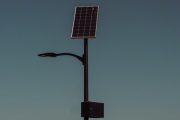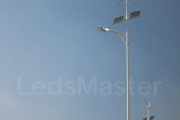Solar power is getting increasing popularity as a dependable source for street lighting all over the world. Some of the benefits associated with solar street lights include reduced dependence on conventional energy, conservation of energy and less reliance on the national grid. In countries experiencing abundance of sunlight, solar lights are the best option to illuminate the streets, garden, parks and other public spaces.
Nowadays, solar street lights are powered by PV panels, in-built battery, LED lights and smart sensors, all integrated into a single compact unit. Solar LED street lights have emerged as a cost-effective and environment-friendly to light up roads and public spaces. LED lights are widely acknowledged for energy conservation, are long-lasting and good-looking, and are maintenance-free. These characteristics make LED-based solar street lights well-suited for commercial as well as domestic lighting applications.
1 Four main component of solar street lights:
a. Solar Panel
The solar panel is one of the most important parts of a solar street light, as the solar panel can convert solar energy into electricity that the lamps can use. There are two types of solar panels commonly used in solar street lights: mono-crystalline and polycrystalline. The conversion rate of mono-crystalline solar panels is much higher than their poly-crystalline counterparts. Solar panels also vary in wattage systems.
b. Lighting Fixture
LEDs are usually used as the primary lighting source of modern solar street lights, as the LED will provide much higher luminosity with lower energy consumption. The energy consumption of an LED fixture is at least 50% lower than the HPS fixture counterpart which is widely used as the lighting source in traditional street lights. A lack of warm-up time in LEDs also allows for use of motion detectors for additional efficiency gains.
c. Rechargeable Battery
Batteries will store the electricity generated by the solar panel during the day and provide energy to the fixture during the night. The life cycle of the battery is very important to the lifetime of the light and the capacity of the battery will affect the backup days of the lights. There are two types of batteries commonly used in solar-powered street lights- gel cell deep cycle batteries as well as lead acid batteries. Lithium-ion batteries are also popular these days as they are compact in size and not prone to theft due to their lack of use in other situations unlike lead acid batteries.
d. Pole
Strong poles are necessary to all street lights, especially to solar street lights as there are often components mounted on the top of the pole: fixtures, panels and sometimes batteries. However, in some newer designs, the PV panels and all electronics are integrated in the pole itself. Wind resistance is also a factor.
In addition, accessories do exist for these types of poles, such as a foundation cage and a battery box.
2 Key Features :
A modern solar street light has embedded solar panel, inbuilt lithium-ion batteries, battery management system, night and motion sensors as well as automatic controls. The fully automatic device comes with LEDs, inbuilt and replaceable Lithium-ion battery and passive infrared (PIR) sensors. A typical solar street light is weather-proof and water-resistant, has low insect attraction rate and low glare and has a longer life.
The embedded solar panel converts solar power into electrical energy which is stored in the inbuilt battery, and used for dusk-to-dawn lighting operations. The main innovation of modern solar street lights is the battery management system which is facilitated by the presence of night and motion sensors.
During the first 5 hours of night, the system works at average lumens brightness. Subsequently, the intensity of the light reduces till dawn or until PIR sensor is activated by human movement. When people are within a certain radius away from the light, it automatically turns to its full brightness. This smart feature makes solar street lights device a perfect combination of renewable energy and energy efficiency.
3 Advantages of solar street lights:
a. No pollution and energy-saving: just need solar energy
Global awareness of the importance of becoming more resource efficient and environmentally friendly has taken hold, and this awareness grows stronger every day. Compared with traditional street lighting, solar street lighting uses solar energy—completely renewable with no consumption of fossil—or any type of—fuel. Solar street lighting realizes environmental protection in a real sense. At the same time, solar lighting will save money in the long term, with no need for paying ongoing electricity charges.
b. Easy construction and maintenance
Solar lighting systems are controlled by built-in intelligence which requires no manual operation, making them safe and economical. The whole construction process is simple and time-saving, while maintenance is infrequent and easy.
c. Less investment: independent and don’t need other electric equipment
Commercial power lighting project is complicated in procedure, involving foundation work of cables ditch digging, cable pipe laying, cable threading inside pipes and ditch landfill, which needs a lot of labors. Meanwhile, the transformer, distribution cabinet, switch board shall cost much money. However, the solar lighting can avoid all of these. Each lighting system is an independent individual, no need of cables laying and electric equipment, both cost-saving and labor-saving.
d. Safety: electric shock or fire
Due to the low voltage of 12-24V, the solar street lamp has stable voltage, reliable operation and no hidden dangers. It is an ideal product for the ecological community and the road administration department. There are no accidents such as electric shock or fire. The safety of the circuit lights in the city is great. People’s living environment is constantly changing. Road reconstruction, landscape engineering construction, the power supply is not normal, and cross-construction of water gas pipelines brings many hidden dangers.
e. Money saving:no cable costs
For remote areas which cannot be covered by commercial power, the cost of laying cables and installing electricity is extremely high. In addition, cable theft can occur. If this happens, the whole power supply will go down.
A solar lighting system completely removes these concerns. Each lamp is independent and free from any cable connection. While there is no cable to steal, if any solar-related theft did occur, it would not affect the operation of any other unit in the system, reducing any potential losses to a minimum.
These 5 comparisons with electricity show some of the obvious benefits that solar street lights have over traditional grid powered sodium street lights. It is easy to see why more and more solar powered LED street lights are being used for public street applications.
4 Disadvantages of Solar Street Lights:
Solar street lights require higher initial investment compared to conventional street lights. This is actually the main reason why most people are having second thoughts about switching to solar street lights. They consider the money they are required to spend without realizing the long-term benefits and the longer life cycle of solar street lights. Because these are non-wired, these can easily be stolen. The risk for theft is relatively higher because it has higher monetary value compared to regular street lights. Snow or dust, and moisture can accumulate on horizontal PV-panels. This leads to reduced or full stoppage of energy production. This is why solar street lights need to be checked once in a while especially when placed on areas with extreme weather conditions, which can damage or shorten the life cycle of it. Rechargeable batteries must be replaced a few times within the lifetime of the fixtures. This adds up to the total lifetime cost of the lighting system.











